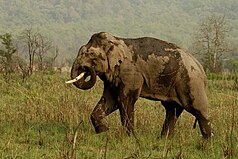Corbett National Park
| Corbett National Park | ||
|---|---|---|
| Wild bull elephant in the national park | ||
|
|
||
| Location: | Uttarakhand , India | |
| Surface: | 521 km² | |
| Founding: | 1936 | |
The Corbett National Park is located in the Indian state of Uttarakhand at the foot of the Himalayas . It is named after the British hunter and conservationist Jim Corbett , who was instrumental in 1936 in establishing the first national park in India near Nainital . Originally it was called Hailey National Park, but in 1957 it was renamed Corbett National Park after it was briefly called Ramganga National Park since 1952. The Corbett National Park covers just under 521 square kilometers. Together with the adjacent Sonanadi Conservation Area, it forms the Corbett Tiger Reserve, which was founded in 1973 as part of the Project Tiger.
The largest river in the park is the Ramganga , which flows into a large lake on the western border of the reserve. The landscape is characterized by wide valleys and hills. A chain of hills runs in an east-west direction in the middle of the area. The main vegetation form is the sal forests , in higher elevations there are also some pine stands. In the lowlands there are river forests, the stocks of which are interrupted by grassy areas, which the locals refer to as "chaurs". It is only open from November to June.
fauna
The main attractions of the park are the Bengal tiger , Indian leopard and wild specimens of the Asian elephant . In addition, it is home to larger mammals the rhesus monkey , Hulman , the golden jackal , the red fox , the Dhole , the black bear , the sloth bear , the Yellow-throated marten , the otter , the Small civet cat , the spotted linsang , the Civet , the masked palm civet , the Indian mongoose , the Bengal , the tube cat , the boar , Muntjak , the axis deer , the pig Hirsch , the Sambarhirsch that nilgai , one type of Gorals , dandruff animals and porcupine . The gavial and the marsh crocodile live in the waters . You can also see around 580 species of birds in the park.
Neighboring reserves
To the west of the Corbett National Park is the Rajaji National Park , which is also home to larger populations of elephants and tigers. However, the area between the two national parks is now largely cultivated land and so only a few corridors remain on which at least individual specimens of the Asian elephant and Bengal tiger can migrate in order to ensure genetic exchange between the otherwise isolated populations . The only corridor that is used more frequently is the Chila Motichur Corridor, which crosses the Ganges. However, this path is particularly impaired by human interference.
photos
See also
literature
- KK Gurung & Raj Singh: Field Guide to the Mammals of the Indian Subcontinent , Academic Press, San Diego, ISBN 0-12-309350-3
- Magnus Elander & Staffan Widstrand: The most beautiful wildlife parks in the world , Berg Verlag, 1994 ISBN 3-7634-1105-4
Individual evidence
- ↑ Protected Area Network in India ( Memento of the original from March 7, 2012 in the Internet Archive ) Info: The archive link was inserted automatically and has not yet been checked. Please check the original and archive link according to the instructions and then remove this notice. Retrieved from moef.nic.in on April 6, 2014.
- ↑ AJT John Singh, S. Narendra Prasad & SP Goyal: Conservation status of the Chila-Motichur corridor for elephant movement in Rajaji-Corbett National Park Area, India . Biological Conservation, Volume 51, Issue 2, 1990, pp. 125-138 doi : 10.1016 / 0006-3207 (90) 90107-Z .
















